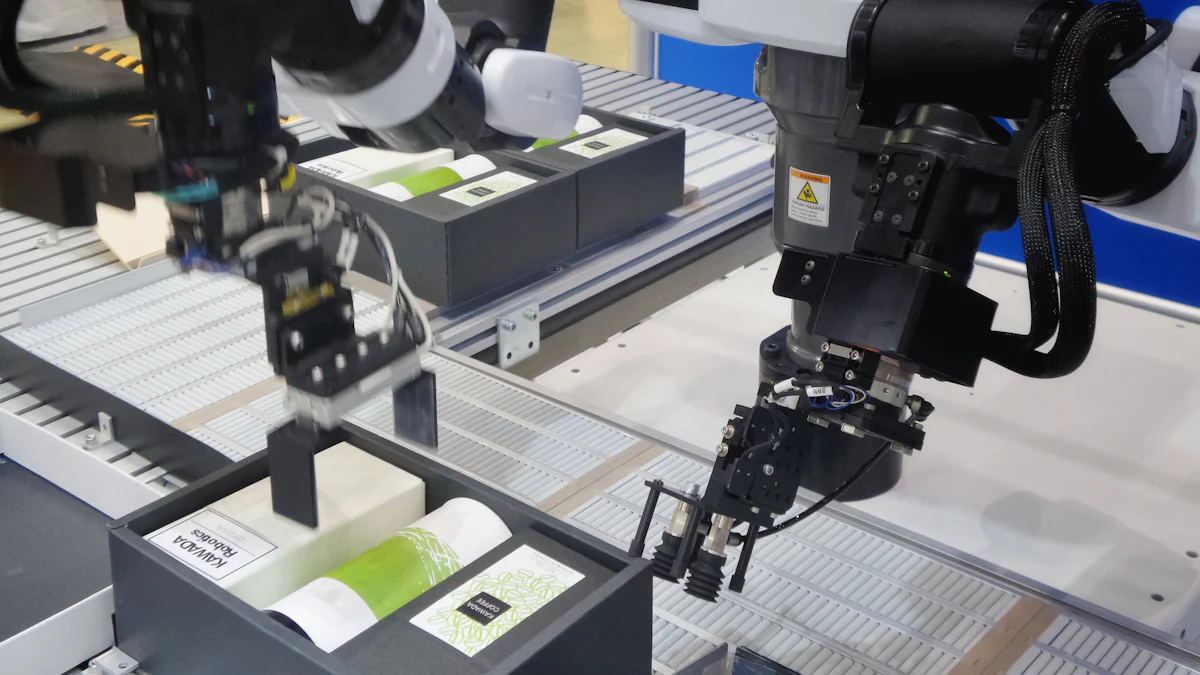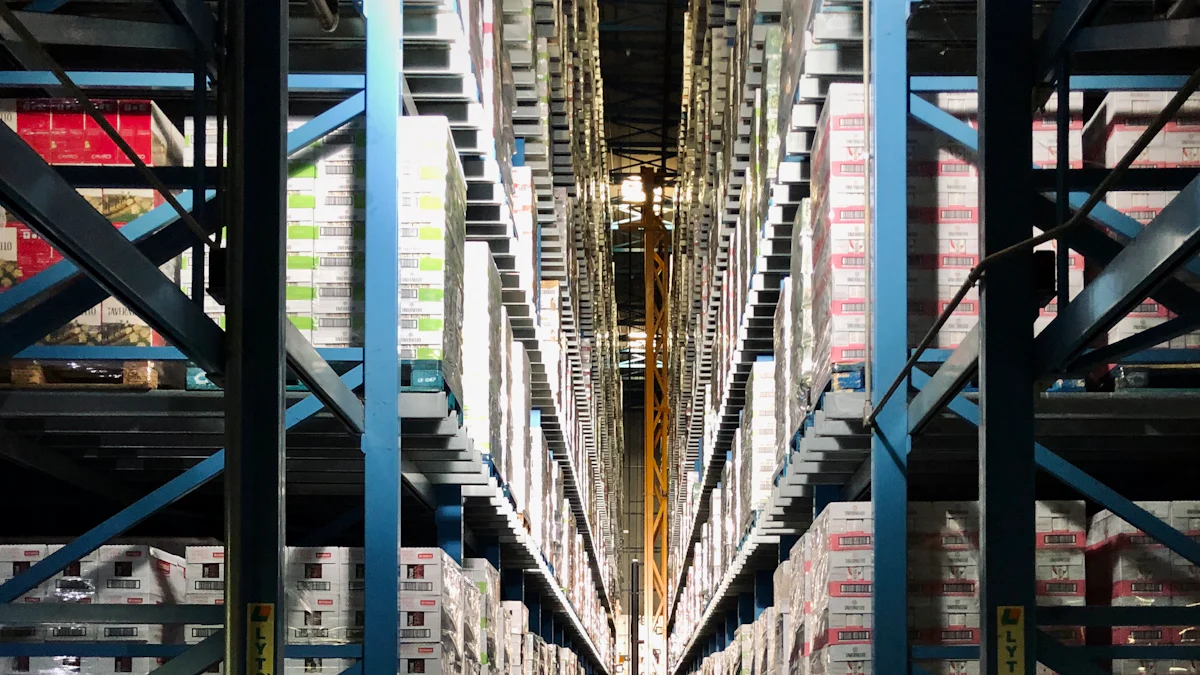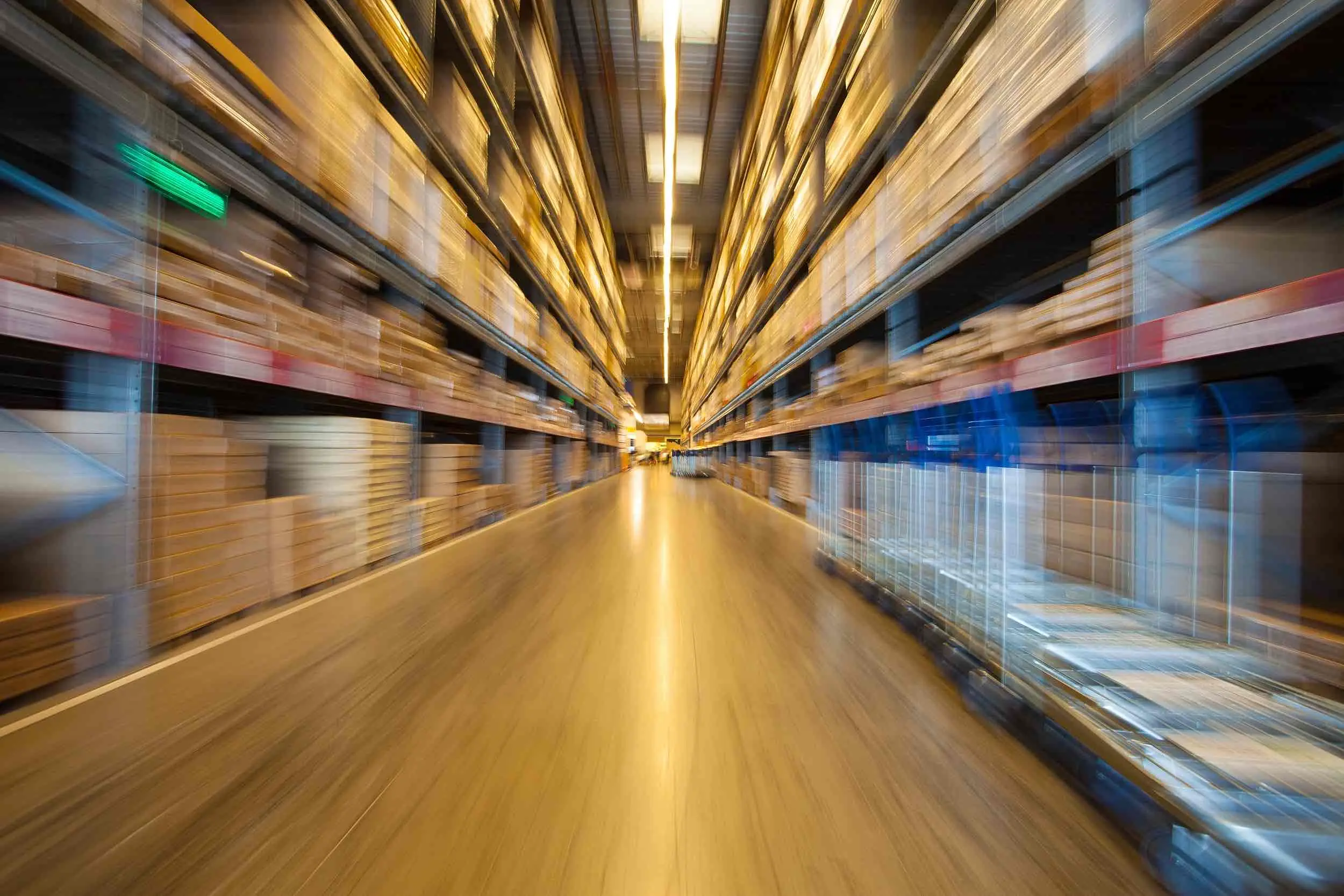Emerging Trends in Supply Chain Automation for 2025
Supply chain automation is revolutionizing industries, offering unparalleled efficiency and precision. Businesses must adopt these innovations to remain competitive in a rapidly evolving market. Recent technological advancements, such as operator assist technology and real-time location systems, have redefined logistics. The Internet of Things (IoT) enables real-time tracking, while cloud computing democratizes access to advanced tools. Autonomous Mobile Robots (AMRs) and Artificial Intelligence (AI) further enhance productivity and decision-making. These supply chain trends underscore the critical role of automation in supply chain operations, ensuring agility and resilience in an increasingly complex global landscape.
The Role of AI and Advanced Technologies in Supply Chain Automation

Artificial Intelligence for Supply Chain Optimization
Predictive analytics for demand forecasting
Artificial intelligence has transformed demand forecasting by leveraging predictive analytics. AI algorithms analyze historical data to predict future demand trends with remarkable accuracy. This capability allows businesses to optimize inventory levels, reducing the risk of stockouts or overstocking. AI-powered forecasting systems also adjust predictions dynamically based on real-time customer demand, ensuring supply chain operations remain agile and responsive. Companies like Coca-Cola have successfully utilized machine learning to enhance resource allocation and minimize waste, showcasing the potential of AI in supply chain optimization.
AI-driven decision-making for supply chain optimization
AI tools empower supply chain managers by providing actionable insights into market trends and operational bottlenecks. These tools analyze vast datasets to identify inefficiencies and recommend strategies for improvement. For instance, a global retailer saved €3.5 million annually by optimizing demand planning through AI-driven software. Additionally, AI detects anomalies in workflows faster than human operators, enabling quicker resolutions. By integrating cognitive predictions, businesses can make informed decisions that enhance overall supply chain performance.
Robotics and Automation in Supply Chains
Autonomous vehicles for transportation
Autonomous vehicles are revolutionizing transportation within supply chains. These vehicles, equipped with advanced sensors and navigation systems, ensure timely and efficient delivery of goods. Companies like Amazon have adopted AI algorithms to optimize delivery routes, reducing costs and improving shipping efficiency. Autonomous robots also handle high-risk tasks, enhancing safety and productivity in logistics operations.
Collaborative robots (cobots) in manufacturing and warehousing
Collaborative robots, or cobots, are reshaping manufacturing and warehousing processes. These robots work alongside human employees, optimizing tasks and minimizing unnecessary movements. Equipped with motion and force sensors, cobots enhance workplace safety by avoiding collisions. Studies reveal that human-robot teams are 85% more productive than humans or robots working alone. In warehouses, cobots streamline picking and packing operations, leading to a two- to threefold increase in productivity.
IoT and Connectivity for Automation in Supply Chain
IoT-enabled sensors for real-time data collection
IoT-enabled sensors play a critical role in real-time data collection across supply chains. These devices monitor location, temperature, and humidity, ensuring the quality and safety of perishable goods. Automated alerts for deviations reduce waste and inefficiencies, particularly in industries like food and pharmaceuticals. Enhanced visibility provided by IoT devices allows businesses to track shipments across global networks, improving operational transparency.
Enhanced visibility across the supply chain
IoT fosters end-to-end visibility in supply chains by connecting factories, warehouses, and transportation networks. Smart factories utilize IoT to create data-driven production environments, improving overall equipment effectiveness. Predictive maintenance, enabled by IoT, ensures maximum uptime by monitoring machine conditions. This interconnected ecosystem enhances supply chain management, enabling businesses to respond proactively to disruptions and maintain operational efficiency.
Automation in Warehousing and Inventory Management with JUSDA

Warehouse Robotics for Supply Chain Optimization
Automated guided vehicles (AGVs) for material handling
Automated guided vehicles (AGVs) have become a cornerstone of warehouse automation. These vehicles navigate warehouses autonomously, transporting materials with precision and efficiency. JUSDA integrates AGVs into its operations to streamline workflows and reduce manual labor. By automating material handling, AGVs minimize errors and improve throughput. This technology enhances supply chain optimization by ensuring consistent and timely movement of goods within warehouses.
Robotic picking and packing systems
Robotic picking and packing systems revolutionize warehouse automation by accelerating order fulfillment processes. These systems use advanced algorithms to identify, pick, and pack items with remarkable accuracy. JUSDA employs these systems to handle high-volume operations, ensuring faster turnaround times. The integration of robotics reduces human intervention, leading to fewer errors and improved productivity. This approach aligns with JUSDA's commitment to delivering efficient and reliable logistics solutions.
Real-Time Tracking and Monitoring in JUSDA Warehouses
RFID and GPS technologies for inventory tracking
JUSDA leverages RFID and GPS technologies to enhance inventory tracking. RFID tags provide real-time updates on inventory status, while GPS ensures precise location tracking. These technologies enable JUSDA to maintain accurate inventory records and reduce discrepancies. Real-time tracking improves operational transparency, allowing businesses to make informed decisions quickly.
Cloud-based platforms for centralized monitoring
Cloud-based platforms play a pivotal role in JUSDA's warehouse automation strategy. These platforms centralize data from multiple sources, providing a unified view of warehouse operations. JUSDA's JusLink platform integrates IoT and cloud computing to offer real-time insights into inventory levels and warehouse performance. Centralized monitoring ensures seamless coordination across supply chain networks, enhancing overall efficiency.
Inventory Optimization with Advanced Automation
AI-powered inventory management systems
JUSDA employs AI-powered systems to optimize inventory management. These systems analyze historical data and current trends to predict inventory needs accurately. By automating inventory planning, JUSDA reduces excess stock and minimizes shortages. This approach ensures that resources are allocated efficiently, supporting supply chain optimization.
Just-in-time (JIT) inventory strategies
JUSDA implements just-in-time (JIT) inventory strategies to align inventory levels with demand. This method reduces storage costs and enhances cash flow by minimizing excess inventory. JUSDA's advanced warehouse automation tools enable precise inventory control, ensuring that goods are available when needed. JIT strategies improve operational agility and responsiveness, meeting the dynamic needs of modern businesses.
JUSDA's warehouse automation solutions demonstrate the transformative potential of technology in supply chain management. By integrating robotics, real-time tracking, and AI-powered systems, JUSDA delivers unparalleled efficiency and reliability.
Sustainability and Risk Management in Supply Chain Automation
Circular supply chain models for waste reduction
Circular supply chain models emphasize sustainability by reducing waste and promoting resource reuse. Companies like Vodafone and H&M have implemented incentivized recycling programs, encouraging customers to return used products for recycling. Similarly, plastic pallet pooling allows businesses to rent reusable pallets, reducing waste and ensuring efficient recycling. These models align with modern supply chain trends, where sustainability is a key focus alongside technological advancements.
Product-as-a-Service Models: Signify maintains control of its LED lights throughout their lifespan, reducing waste and promoting sustainability.
Incentivized Recycling: Vodafone's phone trade-in program and H&M's clothing collection initiative aim to recycle materials effectively.
Plastic Pallet Pooling: Renting reusable plastic pallets minimizes waste compared to traditional wooden pallets.
Cybersecurity in Automated Supply Chains
Protecting IoT devices from cyber threats
IoT devices play a critical role in automation in supply chain operations, but they also introduce cybersecurity risks. Best practices for protecting these devices include network segmentation, patching vulnerabilities, and securing device credentials. Regular monitoring for suspicious activity and implementing identity and access management (IAM) further enhance security. JUSDA employs these measures to safeguard its IoT-enabled systems, ensuring uninterrupted operations.
Best Practice | Description |
|---|---|
Network Segmentation | Isolate IoT and OT devices to limit access and reduce risk. |
Patching Vulnerabilities | Regularly update devices to fix security flaws. |
Securing Device Credentials | Use strong passwords and change default credentials. |
Monitoring for Suspicious Activity | Continuously observe network traffic for anomalies. |
Implementing robust data encryption and monitoring
Data encryption ensures that sensitive information remains secure during transmission and storage. JUSDA integrates robust encryption protocols across its platforms, protecting customer and operational data. Continuous monitoring of systems helps detect and mitigate potential threats, ensuring the integrity of automated supply chains.
Diversifying suppliers to reduce dependency
Diversifying suppliers reduces risks associated with relying on a single source. Companies with diversified supply chains adapt more effectively to market changes and disruptions. During the COVID-19 pandemic, businesses with multiple suppliers maintained continuity by pivoting production to meet urgent needs. Diversification also enhances cost efficiency by leveraging regional price differences and improving procurement terms.
Mitigates risks from geopolitical instability and natural disasters.
Enhances flexibility to adapt to demand fluctuations.
Reduces logistics expenses through strategic placement of production facilities.
Sustainability and risk management are integral to modern supply chain automation. By adopting eco-friendly practices, strengthening cybersecurity, and leveraging AI for risk mitigation, businesses can achieve resilience and efficiency in an increasingly complex global landscape.
Resilience and Agility in Supply Chains with JUSDA Solutions
Decentralized Production Models for Supply Chain Optimization
Localized manufacturing to reduce lead times
Localized manufacturing enhances supply chain efficiency by positioning production facilities closer to end markets. This approach reduces lead times, enabling businesses to respond swiftly to regional demand fluctuations. JUSDA employs localized manufacturing to improve delivery speed and customer satisfaction. By decentralizing operations, companies can mitigate risks associated with global disruptions, such as natural disasters or geopolitical instability.
Advantage | Explanation |
|---|---|
Diversifying operations across multiple locations mitigates the impact of disruptions. | |
Faster Response Times | Proximity to customers enables quicker delivery and better response to regional demand changes. |
Greater Flexibility | Better adaptation to local market conditions and consumer preferences through regional decision-making. |
Flexible Supply Chain Strategies for Automation
Dynamic routing for transportation
Dynamic routing optimizes transportation by continuously adjusting delivery paths based on real-time data. This approach accommodates new orders, traffic conditions, and weather disruptions, ensuring timely deliveries. JUSDA employs dynamic routing to minimize costs and enhance customer satisfaction. Efficient routing reduces fuel consumption and operational expenses while improving service levels.
Continuously optimizes delivery paths using real-time data.
Reduces time on the road, leading to fuel cost savings.
Improves customer satisfaction by meeting delivery windows.
Agile response systems for disruptions
Agile response systems enable businesses to adapt quickly to unexpected challenges. JUSDA integrates automation tools to streamline order processing and inventory management, ensuring rapid responses to supply chain disruptions. These systems enhance operational flexibility, allowing businesses to maintain continuity during crises.
Leveraging Data for Resilience in Supply Chain Automation
Real-time analytics for proactive decision-making
Real-time analytics empowers supply chain leaders to make informed decisions by providing up-to-the-minute insights. JUSDA utilizes real-time data to optimize inventory management, preventing stockouts and overstocking. This approach enhances visibility, enabling businesses to address disruptions before they escalate.
Provides instant insights for proactive decision-making.
Improves inventory management and forecasting.
Enhances agility by responding quickly to market changes.
Digital twins for supply chain modeling
Digital twins offer a comprehensive view of supply chain operations, allowing businesses to analyze dependencies and anticipate disruptions. JUSDA employs digital twins to shift from reactive monitoring to proactive strategies. This technology facilitates detailed analysis of suppliers and components, enabling businesses to implement measures that enhance resilience.

JUSDA Solutions
To provide you with professional solutions and quotations.
Analyzes dependencies and anticipates disruptions.
Facilitates proactive strategies to reduce the impact of potential issues.
Enhances resilience by providing a detailed view of supply chain components.
JUSDA's solutions demonstrate the importance of resilience and agility in modern supply chains. By adopting decentralized production models, flexible strategies, and advanced data analytics, businesses can navigate complexities with confidence.
Collaboration and Digital Integration in Supply Chain Automation
Building Strategic Partnerships with JUSDA
Collaborating with technology providers
Strategic partnerships with technology providers drive innovation in supply chain automation. These collaborations improve production and delivery speeds by integrating advanced tools like robotics and IoT. Automation reduces human error, ensuring accurate inventory management and product delivery. For example, GXO Logistics partnered with Dexterity to enhance warehouse efficiency through automated labeling systems. Similarly, DHL Supply Chain collaborated with Robust.AI to deploy flexible warehouse robots, streamlining material handling. Such partnerships enable faster decision-making by leveraging real-time data, enhancing responsiveness to market changes. JUSDA’s commitment to innovation ensures that its partnerships deliver cost-effective solutions without compromising quality.
Strengthening relationships with suppliers and distributors
Strong relationships with suppliers and distributors enhance communication and align shared goals. This collaboration fosters seamless information flow, reducing delays and improving responsiveness to market trends. By leveraging technology like big data and analytics, stakeholders can predict demand patterns and optimize logistics. JUSDA integrates these practices into its operations, creating a resilient supply chain that adapts to disruptions effectively. Strengthened partnerships also promote transparency, ensuring that all participants work cohesively toward operational excellence.
Digital Connectivity Across the Supply Chain
Blockchain for secure and transparent transactions
Blockchain technology enhances transparency and security in supply chains. It creates an immutable ledger that tracks the provenance of goods, addressing concerns about ethical sourcing and environmental impact. Blockchain also identifies unauthorized product removals, aiding in fraud prevention. By integrating blockchain with IoT and smart contracts, JUSDA ensures compliance with international trade regulations. This approach strengthens trust among partners and customers, fostering a more ethical and efficient supply chain.
Unified platforms for seamless communication
Unified platforms streamline communication by integrating various supply chain functions into a single system. These platforms enable real-time data sharing, ensuring that all teams operate with consistent insights. Collaboration tools within these systems enhance coordination between procurement, logistics, and sales teams. JUSDA’s JusLink platform exemplifies this integration, providing a centralized hub for monitoring and managing supply chain activities. This digital transformation improves operational efficiency and fosters a collaborative environment across digital supply networks.
Enhancing Customer Experience Through Automation
Personalized delivery options through automation
Automation enables personalized delivery options, meeting diverse customer preferences. AI-powered systems analyze customer data to optimize delivery schedules and routes. This customization enhances convenience and satisfaction, encouraging repeat business. JUSDA employs these technologies to offer tailored solutions, ensuring that customers receive their orders efficiently and reliably.
Real-time updates for improved customer satisfaction
Real-time updates enhance customer satisfaction by providing accurate shipment tracking and proactive communication about delays. This transparency builds trust and allows businesses to address disruptions dynamically. JUSDA integrates IoT devices into its operations, offering real-time visibility that exceeds customer expectations. These updates ensure timely deliveries, reinforcing JUSDA’s reputation for reliability and excellence.
Collaboration and digital integration are essential for modern supply chains. By building strategic partnerships, leveraging blockchain, and enhancing customer experiences through automation, JUSDA demonstrates its leadership in creating efficient and transparent supply chain solutions.
The supply chain landscape in 2025 will be shaped by transformative trends, including autonomous mobile robots, AI-driven decision-making, IoT-enabled connectivity, blockchain for transparency, and sustainability-focused automation. These advancements streamline operations, reduce costs, and enhance customer satisfaction.
Businesses must embrace automation to remain competitive. Automation improves efficiency, minimizes errors, and provides real-time insights, enabling informed decision-making and timely deliveries.
Looking ahead, innovations like generative AI and advanced robotics will redefine supply chain management. Companies should invest in these technologies and adopt proactive strategies to navigate disruptions and seize emerging opportunities. Embracing change today ensures resilience and success in tomorrow’s dynamic global market.
See Also
Key Trends Shaping Future Supply Chain Efficiency Today
Robotics Innovations Driving Sustainability In Supply Chain Management
Insights Into AI Integration For Future Supply Chains
